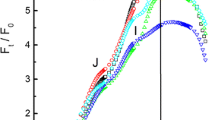Summary
-
1.
The ionic dependency of the flash-triggering action potential (FTP) evoked across the vacuolar membrane inNoctiluca was studied by injecting various salt and pH buffer solutions into the vacuole.
-
2.
Electron microscopic observations showed that the peripheral cytoplasmic compartment sandwiched between vacuole and pellicle is 0.11±0.07 μm in thickness, so that it has a very small volume (Figs. 2 and 15).
-
3.
The resting membrane resistance and capacitance measured across the cell surface were about 10 KΩ·cm2 and 0.8 μF/cm2, respectively. Under normal conditions the FTP, which is 50∼60 mV in amplitude, arises from a potential of −150 to −160 mV.
-
4.
More than a tenfold increase in the concentration of K+, Ca2+, Mg2+, NH +4 , or SO 2−4 in the vacuole produced no significant change in the amplitude of FTP (Figs. 4 and 5).
-
5.
Injections of HCl-glycine buffer solutions of various pH were used to alter the intrinsic vacuolar pH (about 3.5) within the range of 2.5 to 3.7 without damaging the cells. The FTP amplitude rose about 58 mV per unit drop in pH (Figs. 6–9, Table 1).
-
6.
Crude aqueous extracts from the cells emitted light most effectively when the pH was lowered from 8.2 to 5.5. None of the other major cations found in the vacuole showed any effect on the light emission of the extract (Figs. 12 and 13).
-
7.
From these findings, we propose a proton hypothesis explaining the coupling between the bioluminescence and the action potential.
Similar content being viewed by others
Abbreviations
- FTP :
-
flash-triggering action potential
- TRP :
-
tentacle regulating potential
- PVC :
-
perivacuolar cytoplasm
- TTX :
-
tetrodotoxin
References
Chang, J.J.: Electrophysiological studies of a nonluminescent form of the dinoflagellateNoctiluca miliaris. J. Cell. Comp. Physiol. 56, 33–42 (1960)
DeSa, R., Hastings, J.W.: The characterization of scintillons. Bioluminescent particles from the marine dinoflagellate,Gonyaulax polyedra. J. Gen. Physiol.51, 105–122 (1968)
DeSa, R., Hastings, J.W., Vatter, A.E.: Luminescent “crystalline” particles: An organized subcellular bioluminescent system. Science141, 1269–1270 (1963)
Eckert, R.: Bioelectric control of bioluminescence in the dinoflagellateNoctiluca. Science147, 1140–1145 (1965)
Eckert, R.: Bioelectric control of ciliary activity. Science176, 473–481 (1972)
Eckert, R., Reynolds, G.T.: The subcellular origin of bioluminescence inNoctiluca miliaris. J. Gen. Physiol.50, 1429–1458 (1967)
Eckert, R., Sibaoka, T.: Bioelectric regulation of tentacle movement in a dinoflagellate. J. Exp. Biol.47, 433–446 (1967)
Eckert, R., Sibaoka, T.: The flash-triggering action potential of the luminescent dinoflagellateNoctiluca. J. Gen. Physiol.52, 258–282 (1968)
Eckert, R., Naitoh, Y., Machemer, H.: Calcium in the bioelectric and motor functions ofParamecium. Symp. Soc. Exp. Biol.30, 233–255 (1976)
Evans, M.H.: Tetrodotoxin, saxitoxin, and related substances: Their applications in neurobiology. Int. Rev. Neurobiol.15, 83–166 (1972)
Fogel, M., Hastings, J.W.: Bioluminescence: Mechanism and mode of control of scintillon activity. Proc. Natl. Acad. Sci. USA69, 690–693 (1972)
Fogel, M., Schmitter, R.E., Hastings, J.W.: On the physical identity of scintillons: Bioluminescent particles inGonyaulax polyedra. J. Cell Sci.11, 305–317 (1972)
Gross, F.: Zur Biologie und Entwicklungsgeschichte vonNoctiluca miliaris. Arch. Protistenk.83, 178–196 (1934)
Hastings, J.W.: Bioluminescence. Annu. Rev. Biochem.37, 597–630 (1968)
Hastings, J.W., Vergin, M., DeSa, R.: Scintillons: The biochemistry of dinoflagellate bioluminescence. In: Bioluminescence in progress. Johnson, F.A., Haneda, Y. (eds.), pp. 301–329. Princeton, New Jersey: Princeton University Press 1966
Kofoid, C.A., Swezy, O.: The free-living unarmored Dinoflagellata. Mem. Univ. Calif.5, 1–562 (1921)
Narahashi, T.: Chemicals as tools in the study of excitable membranes. Physiol. Rev.54, 813–889 (1974)
Nawata, T., Sibaoka, T.: Ionic composition and pH of the vacuolar sap in marine dinoflagellateNoctiluca. Plant Cell Physiol.17, 265–272 (1976)
Nicol, J.A.C.: Observations on luminescence inNoctiluca. J. Mar. Biol. Ass. U.K.37, 535–549 (1958)
Pratje, A.:Noctiluca miliaris Suriray. Beiträge zur Morphologie, Physiologie und Cytologie. I. Morphologie und Physiologie. Arch. Protistenk.42, 1–98 (1921)
Sibaoka, T., Eckert, R.: An electrophysiological study of the tentacle-regulating potentials inNoctiluca. J. Exp. Biol.47, 447–459 (1967)
Spencer, C.P.: The chemistry of ethylenediamine tetraacetic acid in sea water. J. Mar. Biol. Ass. U.K.37, 127–144 (1958)
Author information
Authors and Affiliations
Additional information
This paper was based on a thesis by T. N. submitted to the graduate school of the Tohoku University in partial fullfilment of the requirements for the Ph. D. degree. This work was supported in part by a grant from the Ministry of Education to T. S. We are indebted to Prof. R. Eckert, University of California at Los Angeles, for helpful reading of the manuscript.
Rights and permissions
About this article
Cite this article
Nawata, T., Sibaoka, T. Coupling between action potential and bioluminescence inNoctiluca: Effects of inorganic ions and pH in vacuolar sap. J. Comp. Physiol. 134, 137–149 (1979). https://doi.org/10.1007/BF00610472
Accepted:
Issue Date:
DOI: https://doi.org/10.1007/BF00610472




